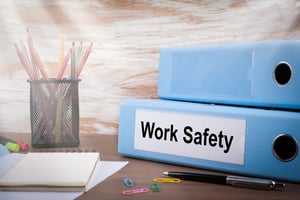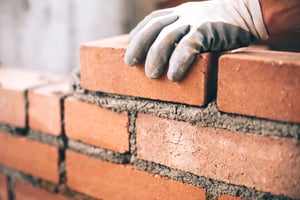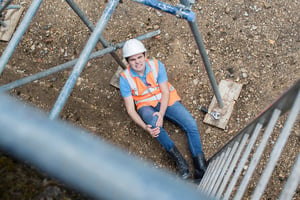 Despite all of your best efforts to create a safe work environment, accidents do happen on worksites – whether it’s a restaurant or a construction site or even an office, and you should be prepared.
Despite all of your best efforts to create a safe work environment, accidents do happen on worksites – whether it’s a restaurant or a construction site or even an office, and you should be prepared.
Knowing what to do when someone injures themselves in the workplace can help ensure that the injured employee gets immediate medical attention and that any Workers’ Comp insurance claims are processed quickly and accurately. You should have a process in place, and all managers and supervisors should be trained in that process.
Here Are Four Steps That Should Be Included in the Process:
Take Care of the Injured Employee
Your employee’s welfare should be your first priority. As soon as an injury occurs, determine the appropriate medical treatment. If it’s a serious injury, call 911 immediately. If it isn’t a serious injury, take the injured employee to a medical care facility.
Some insurance carriers offer a 24/7 injured employee hotline that has registered nurses who can provide medical guidance. If your Workers’ Comp insurance carrier has a hotline, all managers and supervisors should be aware of that number.
Survey the Scene of the Accident
Once the injured employee has received appropriate medical care, survey the scene. If it’s a severe injury, any equipment involved in the incident should be secured, and the area where the incident occurred should be cordoned off with cones or tape until the local police and/or the Occupational Safety and Health Administration (OSHA) are finished with their formal investigation.
Even with minor injuries, surveying the scene could reveal what caused the injury. For example, if an employee falls because of a wet floor, that area can be cleaned up to avoid further accidents.
The purpose of an investigation isn’t to lay blame but to determine the root cause of the accident, so it doesn’t happen again. In that same example, if a faulty refrigerator caused that wet floor, the appliance can be fixed to avoid any additional injuries.
Collect Information
A manager or supervisor should then gather details about the incident. Write down the details of the accident – where it happened, how it happened, etc. – and any medical treatment the injured employee received. Also, talk to anyone who witnessed the incident and document what they share and their contact information.
Complete the Incident Report
Before the details of the injury fade from memory, the incident report should be completed. OSHA requires employers to maintain records of all work-related injuries using its Injury & Illness Record-keeping Forms and to notify OSHA if the injured employee needs to be hospitalized.
Any Workers’ Compensation claims should be filed within 24 hours of the incident.
If the injury is fairly minor but still prohibits the injured employee from performing his or her regular tasks, you may also need to consider if a transitional or modified job may be appropriate. The longer an employee is out of work, the harder it is to go back and the more it costs you. A return-to-work program can help keep injured employees off of long-term disability and save you money.
You may also want to take a look at your safety program. Did an employee not receive proper training? Was a safety procedure ignored? What can you do to help ensure this type of accident doesn’t happen again?
Want to Save on All Kinds of Commercial Insurance?
The agents at American Insuring Group specialize in commercial insurance, including Workers’ Compensation. We can help ensure that you have the right coverage and – as independent agents who can compare costs with several companies – that you get it at the best price! Give us a call at (800) 947-1270 or (610) 775-3848 or connect with us online.



 We often discuss safety and how it can help businesses save on
We often discuss safety and how it can help businesses save on  As the
As the  Filing a
Filing a  As a restaurant owner, your number one priority should be ensuring the safety of the food you serve. Beyond the human element of food safety, foodborne illness can result in negative publicity, huge fines, possible jail time, lawsuits, and higher
As a restaurant owner, your number one priority should be ensuring the safety of the food you serve. Beyond the human element of food safety, foodborne illness can result in negative publicity, huge fines, possible jail time, lawsuits, and higher  Construction is one of the most hazardous occupations today, and masonry contractors are no exception. According to Masonry Magazine, masonry construction is one of the high-risk specialty trades with a nonfatal injury rate of 191.5 per 10,000 equivalent full-time workers.
Construction is one of the most hazardous occupations today, and masonry contractors are no exception. According to Masonry Magazine, masonry construction is one of the high-risk specialty trades with a nonfatal injury rate of 191.5 per 10,000 equivalent full-time workers. Since the passing of the
Since the passing of the  Recent disasters both near, like the flooding in Berks County, and far, like the destructive fire at the Notre Dame Cathedral, has many homeowners wondering whether they have enough
Recent disasters both near, like the flooding in Berks County, and far, like the destructive fire at the Notre Dame Cathedral, has many homeowners wondering whether they have enough  Sometimes when an employee is injured on the job and files a
Sometimes when an employee is injured on the job and files a  There is no denying that we live in a litigious society, and restaurants are not immune to lawsuits. In fact, the very nature of the business often makes them more vulnerable to lawsuits. Don’t believe us?
There is no denying that we live in a litigious society, and restaurants are not immune to lawsuits. In fact, the very nature of the business often makes them more vulnerable to lawsuits. Don’t believe us?



